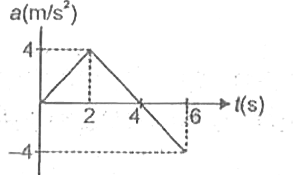Shown plane mirror is lying in y-z plane. A particle P has velocity →u=5ˆi+6ˆj at t=0 & acceleration →a=2tˆj. Velocity of its image at t=2s relative to it is
_E01_050_Q01.png) Solution in Gujrati
Solution in Gujrati
(a)10ˆi
(b)−10ˆi
(c)20ˆj
(d)−20ˆj
The correct Answer is:B
vI=2vM−v0
= 2×0−(5ˆi+(6+2t)ˆj)
vI=−5ˆi+10ˆj,v10=vI−v0
hence vIo=−5ˆi+10ˆj−(5ˆi+10ˆj)
[ at t= 2 sec] = −10ˆi
_E01_050_S01.png)
Topper's Solved these Questions
- GEOMETRICAL OPTICSBOOK - ALLEN CHAPTER - GEOMETRICAL OPTICSEXERCISE - EXERCISE-3
12 Videos
- GEOMETRICAL OPTICSBOOK - ALLEN CHAPTER - GEOMETRICAL OPTICSEXERCISE - EXERCISE-04[A]
23 Videos
- GEOMETRICAL OPTICSBOOK - ALLEN CHAPTER - GEOMETRICAL OPTICSEXERCISE - EXERCISE- 01
45 Videos
- CURRENT ELECTRICITYBOOK - ALLEN CHAPTER - CURRENT ELECTRICITYEXERCISE - EX.II
66 Videos
- GRAVITATIONBOOK - ALLEN CHAPTER - GRAVITATIONEXERCISE - EXERCISE 4
9 Videos
Similar Questions
Plane mirrors are arranged parallel to each other as shown in column-I and the number of images formed by the combination is in column- II
_E01_090_S01.png)
View SolutionA plane mirror of circular shape with radius r=20cm is fixed to the ceiling .A bulb is to be placed on the axis of the mirror.A circular area of radius R=1m on the floor is to be illuminated after reflection of light from the mirror. The height of the room is 3m What is maximum distance from the center of the mirror and the bulb so that the required area is illuminated?
View SolutionTwo plane mirror M1andM2 are inclined to each other at 70∘. A ray incident on the mirror M1 at an angle θ fallls on M2 and is then reflected parallel to M1 for
View SolutionIn the Bohr's model of hy drogen atom, the electron moves around the nucleus in a circular orbit of radius 5×10−11m. Its time period is 1.5×10−16s. The current associated with the electron motion is:-
View SolutionAssertion : The difference in the value of acceleration due to gravity at pole and equator is proportional to square of angular velocity of earth.
Reason : the value of acceleration due to gravity is minimum at the equator and maximum at the pole.
View SolutionVelocity and acceleration of a particle at time t=0 are u=(2 hati+3 hatj) m//s and a=(4 hati+3 hatj) m//s^2 respectively. Find the velocity and displacement if particle at t=2s.
View SolutionVelocity of a particle in x-y plane at any time t is v=(2tˆi+3t2ˆj)m/s At t=0, particle starts from the co-ordinates (2m,4m). Find
(a) acceleration of the particle at t=1s.
(b) position vector and co-ordinates of the particle at t=2s.
View SolutionA plane mirror is lying in x-y plane .Object velocity is V_0=(2 hati-3 hatj+4 hatk) m//s . Find the image velocity.
View SolutionA person walks at a velocity v in a straight line forming an angle alpha with the plane of a mirror. Determine the velocity v_("rel") which he approaches his image, assuming that the object and its image are symmetric relative to the plane of the mirror.
View SolutionThe velocity of a particle at t=0 "is"vecU = 4hati+3hatj"m"//"sec" and a constant acceleration is veca=6hati+4hatj"m"//"sec"^(2) . Find the velocity and displacement of the particle at t=2 sec.
View SolutionThe velocity of an object at t =0 is vecv_(0) =- 4 hatj m/s . It moves in plane with constant acceleration veca = ( 3hati + 8 hatj) m//s^(2) . What is its velocity after 1 s?
View SolutionFor the acceleration - time (a - t) graph shown in figure, the change in velocity of particle from t = 0 to t = 6 s is

View SolutionA particle is given an initial velocity of vecu=(3 hati+4 hatj) m//s . Acceleration of the particle is veca=(3t^(2) +2 thatj) m//s^(2) . Find the velocity of particle at t=2s.
View SolutionVelocity and acceleration of a particle at time t=0 are →u=(2ˆi+3ˆj)m/s s and a=(4ˆi+2ˆj)m/s2 respectively. Find the velocity and displacement of particle at t = 2s.
View SolutionVelocity and accleration of a [article at time t=0 are →u=(2ˆi+3ˆj)m/s and →a=(4ˆi+2ˆj)m/s2 respectively.
Find the velocity and dispalcement of the particle at t-2s.
View SolutionAcceleration of a particle at any time t is veca=(2thatj+3t^(2)hatj)m//s^(2) .If initially particle is at rest, find the velocity of the particle at time t=2s.
View Solution
